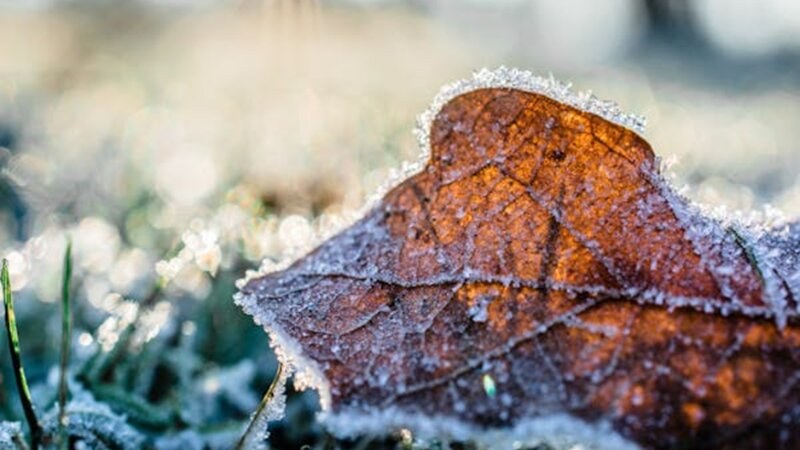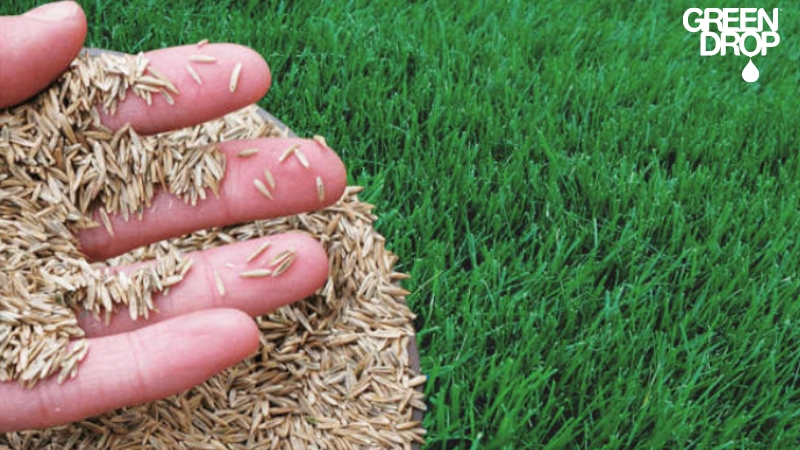When Is It Too Late to Aerate and Overseed? Our Certified GreenKeeper's Guide
Reading time: 6 minutesYou already know aeration and overseeding are key components of a healthy lawn. But when is the right time? Or, more importantly, when is it too late?
Here’s what you need to know and how Green Drop can help you keep your lawn looking its best.
Late Fall Is Too Late

Lawn aeration and overseeding are best done in the early fall, ideally at least a few weeks before the first frost of the year is due. If you wait to aerate and overseed until too late in the fall, the ground might not be frozen hard yet, but your new grass may not have enough time to get established before the temperatures drop. And we don’t want that.
You either want to make sure that young grass has rooted and started growing a little before it starts to snow or ensure it stays dormant until the spring. Somewhere in the middle can mean poor to no germination at all.
Missing Your Spring Window

You can also aerate and overseed when you're preparing your lawn for spring, but if you haven’t done it by June, that’s okay—it’s probably better to just wait until the fall. Just like aerating too soon before winter can cause new grass blades not to emerge, so can aerating too soon before summer. Young grass can dehydrate quickly in hot, dry conditions, especially when it’s a cool-season variety. So we need to really take care of those little guys.
What Happens Next
If you missed the opportunity to aerate your yard this season, you can always wait for the next one. Besides preventing new grass from growing, aerating too late in the winter can cause ice and snow to accumulate on your bare soil, which may damage your existing lawn. And trying to aerate when it’s already too hot outside is a recipe for drying out your soil.
Instead, focus on doing what lawn care you can, like mowing your lawn properly, watering at the right times, and making sure your grass has the right nutrients. We can help you create a lawn maintenance strategy that covers all the bases so you never have to worry about missing your chance to strengthen and improve the look of your lawn.

Other Mistakes to Avoid
Timing isn’t the only thing we want to keep in mind when it comes to properly aerating and overseeding your lawn. Here are some other mistakes you can avoid:
Using the Wrong Equipment
Spike aerators further impact your soil, and liquid aeration leaves a lot to be desired. Using a core aerator is key to getting good results.
Aerating when your Soil is Too Dry or Wet
If you try to aerate when your soil is too wet, things may get muddy fast. If your soil is too dry, the aerator equipment will have difficulty penetrating the hard ground and pulling good plugs from the lawn.
Mowing Too Short
While it’s recommended that you mow your lawn shorter than usual before aerating and overseeding, going too far could risk scalping your lawn. Generally, your grass should be about 1.5–2 inches when you start the aeration process.
Using Weed Control Methods Too Soon After Overseeding
Your lawn may look less than pleasant for the first few weeks. Don’t worry, this is normal.
Working with a qualified lawn care professional like our GreenKeepers at Green Drop can eliminate the potential for costly mistakes, ensuring the correct type of control products are applied at the appropriate time to ensure your lawn looks great, no matter its condition.
Answering Your Questions About Aerating and Overseeding
When do I water my lawn after aerating it?
Seeds need moisture to germinate, so your lawn should be watered as soon as you finish overseeding. You should saturate your entire lawn and then continue watering evenly for about 20 minutes per day for the first week or so. Then, you should be able to return to a regular lawn watering schedule 2–3 times per week.
When should I use lawn fertilizer after aeration and overseeding?
Fertilizing right after an aeration and overseeding is fine. This gives the lawn a boost of nutrients as the grass seed roots and helps them to establish strength and hardiness quickly.
However, after that application, you’ll want to wait about 4 weeks before fertilizing again. This is because some lawn fertilizers' high concentrations of nitrogen, phosphorus, and potassium can impact new blades before they have a chance to develop.
How long should I wait to mow my lawn after overseeding it?
You can expect your lawn to look a little unkempt for the first few weeks after you aerate and overseed. This is because you want to allow new grass seeds to sprout and develop a root system before cutting them short.
Remember, blades of grass are actually leaves; that’s how your lawn gets sunlight for photosynthesis. When you cut new grass, you remove its ability to make food. Wait to mow until you see the young grass popping up, which usually happens about 3–4 weeks after planting. If you want to mow sooner to help break up the plugs or your other grass is growing too quickly, simply make sure that you mulch instead of bag your clippings. This will keep any ungerminated seed where it needs to be on the lawn.
Can I rake the plugs?
While you can technically rake up the soil plugs after aerating to give your lawn a cleaner look, we don’t recommend it. These plugs contain nutrients and organic matter that can be recycled back into your soil if left alone. Rain, wind, and watering will break the plugs down sooner than you think.
What kind of grass seed should I use?

The best grass seed for overseeding in Western Canada is a mix of high-quality, cool-season grasses. This helps ensure your lawn has a thick, green appearance without patchiness and can survive the cold winter months.
Cool-season grasses also have the added benefits of establishing quickly and helping to control soil erosion. They do have higher nutrient demands than most warm-season grasses, but this is easily managed with good watering and fertilization schedules.
What if I have underground cables or a sprinkler system?
If you have an in-ground sprinkler system or underground cables, you may need to mark these with utility flags or paint before going over your lawn with an aerator. Then, we avoid these areas.
Even though most major utility cables are buried deep enough that an aerator won’t be able to reach them, it’s common for internet and telephone cables to be buried more shallowly. Finding and marking them before aeration may be necessary in some cases.
Green Drop—Western Canada Trusted Lawn Care Service Provider
As a top provider of lawn care services in Western Canada, Green Drop is proud to offer lawn care packages that take the stress of maintaining your lawn off your shoulders.
Whether you need lawn fertilizer services and weed control or want your lawn to be the envy of the neighbourhood, our experienced GreenKeepers are here to help.
We serve the following cities and surrounding areas: Calgary, Edmonton, Red Deer, Regina, Saskatoon, and Winnipeg.

